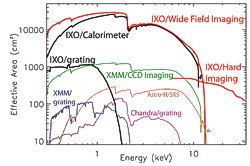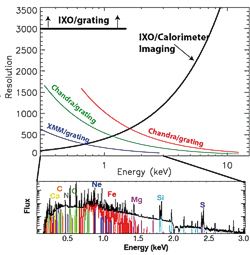 |
Goddard Space
Flight Center NASA > GSFC > Astrophysics Science Division > IXO |
|

| Parameter | Requirement | Science Drivers | Instruments |
| Mirror Effective Area |
3 m2 @1.25 keV
0.65 m2 @ 6 keV 0.015 m2 @ 30 keV |
Black Hole Evolution Strong gravity Strong gravity |
|
| Spectral Resolution (FWHM), FOV, bandpass | ΔE = 2.5 eV, 2 arcmin, 0.3 – 7 keV ΔE = 10 eV, 5 arcmin, 0.3 – 7 keV ΔE =150 eV, 18 arcmin, 0.1– 15 keV E/ΔE = 3000, point src, 0.3 – 1 keV |
Galaxy Cluster Evolution Cosmic Feedback Black Hole Evolution Cosmic Web |
XMS XMS WFI/HXI XGS |
| Angular Resolution | 5 arcsec HPD, 0.3 – 7 keV 5 arcsec HPD, 0.3 – 7 keV 30 arcsec HPD, 7.0 – 40 keV |
Cosmic feedback, Black Hole Evolution Strong Gravity |
XMS WFI/HXI WFI/HXI |
| Count Rate | 106 cps with < 10% deadtime | Neutron Star Equation of State | HTRS |
| Polarimetry | 1% MDP, 100 ksec, 5×10-12 cgs (2–6 keV) |
Strong Gravity | XPOL |

Plot of the effective area of the IXO mirror and focal plane instruments compared to those of current X-ray observatories, showing the large improvement at all energies. Credit: NASA/GSFC. Click the image for a larger view

Plot of the spectral resolution of the IXO calorimeter and grating (lower limit) compared to current X-ray observatories. The bottom panel shows the emission lines of the various elements in the energy range 0.1-3.0 keV (color) and their sum (black). Credit: NASA/GSFC. Click the image for a larger view
Available from here »